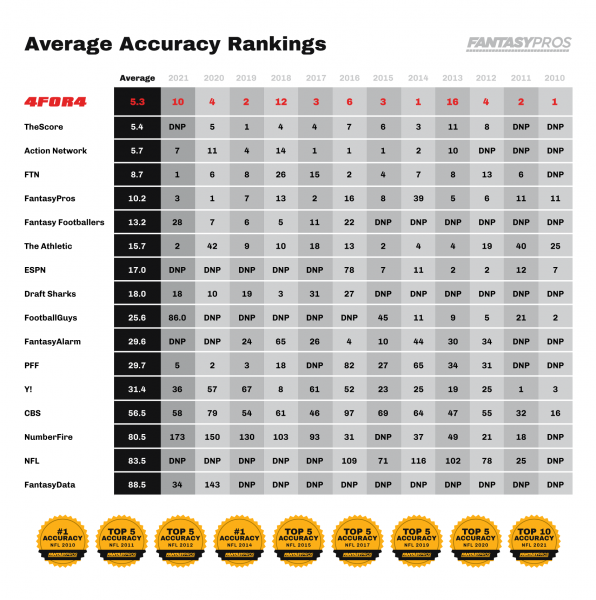If you want to win your league this year, you need verified-accurate in-season rankings, decision support tools, weekly reports and a little bit of luck. Find out how subscribing to 4for4 Fantasy Football can help you make the playoffs and WIN!
Subscribe Today ⟶
The Most Accurate Rankings & Projections Since 2010
If there's one thing that we've learned in our decades of experience playing fantasy football, it's that consistently accurate preseason and in-season rankings are the foundation for success.
We're proud to have John Paulsen, one of fantasy football's most accurate expert, on staff, working hard every day to provide our subscribers with the most accurate rankings and projections available.
Paulsen was named the Most Accurate Fantasy Football Expert by FantasyPros in both 2010 and 2014 and was the runner-up in 2011 and 2019. In 2012, 2015, 2017 and 2020 he finished in the top four.
Draft With the Most Accurate Rankings ⟶

According to FantasyPros, no one has been more consistently accurate than Paulsen, who has finished top six in 9 of the past 11 seasons.
FREE Live Draft Software (Draft Hero)
Our FREE draft software makes thousands of calculations and sees patterns not humanly possible to find in the sixty seconds you have to make your pick. Your savvy fantasy football mind + our FREE draft software = an unbeatable draft. PLUS, it can pull all your league information and LIVE sync with your ESPN, Yahoo!, MyFantasyLeague, and RT Sports draft! Available for desktop and mobile devices.
Draft Smarter ⟶
Customize Your Rankings
With Full Impact and LeagueSync, you don't have to worry about downloading files and messy installations. Just enter your league information online once and you are all set. Our tools are fully integrated and can accommodate all of your leagues with the touch of a button.
Full Impact and LeagueSync is all about providing customized analysis for your roster and your league, providing interactive analysis and decision support tools tailored to you.
Import & Sync Your League ⟶
16 Decision Support Tools & 38 Weekly Reports
In addition to our cheat sheets, rankings and projections, we provide a number of draft and in-season decision support tools. Once the season starts, hang on! We keep you competitive and give you an edge all season long, providing you with various weekly-updated reports.
Compare Subscriptions ⟶
DFS and Betting Content & Tools
To access our Lineup Generator, which uses our most accurate projections to build up to 500 daily fantasy football lineups (FanDuel, DraftKings, Yahoo!), you will require our DFS Subscription. The DFS Subscription also comes with floor and ceiling projections, top picks and lineups from DFS Expert, Chris Raybon, stack value reports and more.
Increase Your Bankroll ⟶